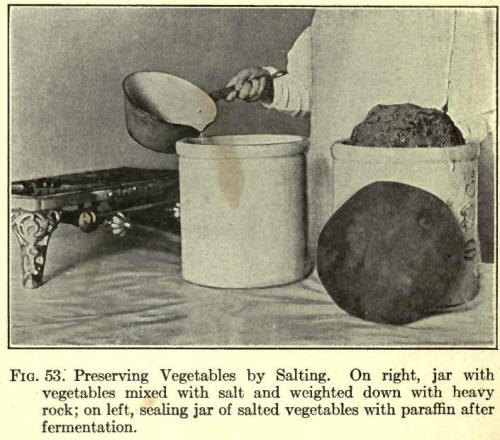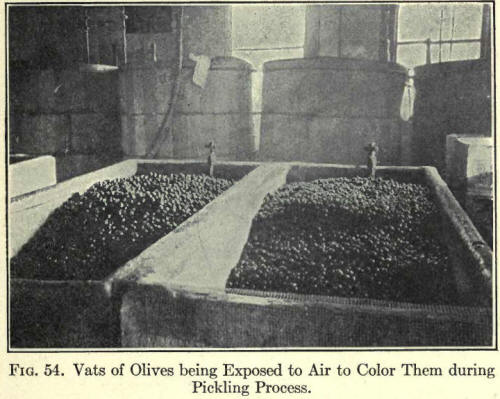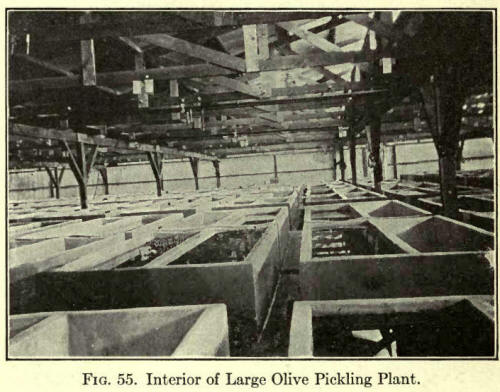|
A great variety of
pickles may be made from vegetables and to a less degree from fruits.
These include such things as cucumber pickles, dill pickles, sauerkraut,
ripe olives, and sweet fruit and vegetable pickles.
The preservation of
vegetables by salting and fermentation involves principles similar to
those of pickling, and, therefore, this method of preservation is
considered with pickling.
96. Preservation of
Vegetables by Salt. Many vegetables may be preserved in salt or
strong brine without causing any marked changes in flavor or composition
of the vegetables. The salt acts as an antiseptic and prevents spoiling.
There are three ways in which the salt is used. The vegetables may be
mixed with dry salt in sufficient quantity to completely prevent the
growth of all microorganisms, or only a small amount of dry salt is
added and fermentation is allowed to take place, the products of
fermentation, together with the salt, preserving the vegetables; or a
very strong brine may be made up and the vegetables stored in this
without fermentation.
(a) Dry Salting. In this
method the vegetables are prepared fresh as for cooking for the table.
Carrots, beets, and turnips are peeled and sliced; string beans are
broken into short pieces and corn is cut from the cob. Onions and peas
do not respond well to salting. Corn and string beans are excellent when
salted.
One pound of salt is
weighed out and mixed with each three to four pounds of vegetables in a
stoneware jar or in an open barrel. The salt and vegetables are built up
in alternate layers and a wooden cover to fit inside the container and
heavily weighted, is placed on the vegetables. The salt and pressure
draw the juice from the vegetables. This forms a concentrated brine in
which the vegetables will keep indefinitely. They should be sealed with
paraffin after about two weeks to check evaporation of the liquid. The
vegetables must be freshened in water by soaking in cold water or by
parboiling before use for cooking. They will keep indefinitely in this
way.
(b) Salt and
Fermentation. In this method a small amount of salt (one-half pound to
each ten pounds of vegetables) is used. This permits the growth of
yeasts and lactic acid bacteria, but prevents the growth of putrefactive
bacteria. It does not prevent the growth of mold; molding must be
checked by exclusion of air. The lactic acid formed in the fermentation
is the main factor in the preservation of the vegetables. Cabbage,
string beans, sliced beets, greens, sliced root vegetables, all lend
themselves very well to this process. In Belgium and Holland, it is said
that this is the most common way of preserving all kinds of vegetables.
Vegetables preserved by
this method possess a "sauerkraut" flavor which varies with the kind of
vegetable preserved.
The jar or barrel must be
kept sealed after fermentation is over. Jars are sealed by pouring a
thick layer of paraffin over the fermented vegetables. This is added ten
days to two weeks after mixing the salt and vegetables. When vegetables
are taken out for use the paraffin coating must be replaced in order
that molding will not take place.
Barrels may be fitted
with a six-inch bung in one head. The vegetables and salt are packed in
with the head removed and is so left until fermentation is over. The
barrel is then headed up and brine of the same strength as that on the
vegetables (one pound of salt per gallon of water) is added to fill the
barrel completely and the barrel is sealed with the hung. As the
vegetables are taken out they are replaced with brine.

(c) Strong Brine. A few
vegetables cannot be preserved satisfactorily by methods "a" and "b."
Some of these may be stored in a very strong brine made of three and
one- half to four pounds of salt per gallon of water. No fermentation
can take place in this high concentration of salt. Large peppers,
cauliflower, artichokes, and asparagus, are examples of vegetables that
can be successfully preserved in this way.
The vegetables will float
because of the buoyant action of the brine. Wooden floats must be used
to keep the vegetables submerged to prevent molding.
The vegetables must be
freshened before use. A convenient way of doing this is to suspend them
in a coarse bag or colander in the top of a large pot of water. The salt
rapidly dissolves out and is carried away by the large volume of water
beneath the vegetables. This method is much more rapid than that of
placing the vegetables in the bottom of a pot of water.
See Recipes 99, 100, and
101, Part III.
97. Dill Pickles.
Dill pickles are made by the fermentation of cucumbers in a brine in the
presence of dill weed and spices and with the exclusion of air. Lactic
acid is formed and gives the characteristic sauerkraut flavor to this
style of pickle. The brine used is about one- half pound of salt per
gallon of water. A small amount of vinegar added to the brine will
prevent softening by injurious bacterial growth. The amount of vinegar
needed is three-quarters of a quart per ten quarts of brine.

Dill pickles may be made
in stoneware crocks but better results are obtained in barrels.
Exclusion of air is essential.
Fermentation requires
from five days to a month, depending on the temperature. The finished
pickles should be canned and sterilized to prevent deterioration. (See
Recipe 104 for specific directions.)
98. Pickling
Vegetables in Vinegar. Cucumbers, green tomatoes, onions, small
peppers, beets, and cauliflower are the vegetables most commonly
preserved in vinegar. The processes of pickling consist of a preliminary
treatment to prepare them for the vinegar and secondly, of the storage
in plain or sweetened vinegar. The vinegar is the preserving agent,
sterilization being unnecessary.
(a) Storage in Brine.
Most vegetables for pickling should be stored in brine a few weeks to
remove disagreeable flavors before placing them in vinegar. Cucumbers
are stored for about two weeks in a brine consisting of one and
three-fourths pounds of salt to the gallon of water; this is then
increased to two and one- half pounds per gallon and the cucumbers held
in this until needed for final pickling in vinegar. Fermentation takes
place during storage, the green color fades to an olive green, the acrid
flavor disappears, lactic acid is formed from the sugar, and the texture
and flavor improved. The cucumbers must be kept submerged in the brine.
This can be done with a wooden float. Should softening set in more salt
must be added. Softening is the result of harmful bacterial or mold
growth. This is checked by increasing the salt content. Onions,
cauliflower, and green tomatoes are stored in a brine of three and
one-half pounds of salt per gallon for two weeks or longer before
pickling. Peppers are stored in wooden barrels, filled with a brine of
the same strength as directed for use on cucumbers. After fermentation,
the barrel is closed and stored until peppers are used in vinegar. Beets
are not stored in salt.
(b) Removal of Salt. The
salt must be removed from the vegetables by soaking in cold water, or by
heating in several changes of water to about 120º to 150º F. A
teaspoonful of alum per gallon of hot water used will make cucumbers
more crisp. Several hours' heating are usually necessary to remove the
salt.
(c) Addition of Vinegar.
Good cider vinegar should be used. If the salt has been removed from the
vegetables by soaking in cold water the vinegar is added to the pickles
boiling hot; if it has been removed by heating in water to 120° to 150°
F. The vinegar is added cold. The vinegar may be spiced or sweetened by
methods given in Recipe 107. The pickles will be ready for use after two
or three weeks' storage in vinegar.
99. Pickling Fruits in
Vinegar. Fruits, especially figs and peaches, are often made into
sweet pickles by the addition of a spiced and sweetened vinegar to the
cooked fruit or by cooking the fruit in this sweetened liquor. (See
Recipe 108.)
100. Olives. The
olive pickling industry is one of the most important of California's
fruit industries. Arizona is the only other state growing olives
commercially.
Olives are pickled both
green and ripe, although green pickled olives are no longer produced
commercially in the United States.
Olives before pickling
are extremely bitter in flavor. The pickling process is largely one of
removing this bitterness.
(a) Pickled Ripe Olives.
The olives should be of good pickling varieties such as Mission,
Manzanillo, Sevillano, or Ascolano, and should be ripe. They are ripe
when cherry red to black in color. They should not be overripe and soft
or badly injured by frost.
Wooden or stoneware
vessels must be used for olive pickling. Never use metal.

The first step in the
treatment is the addition of a lye solution of approximately three
ounces (three tablespoonfuls) of soda lye to the gallon of water. This
solution is allowed to penetrate through the skins of the olives and a
little way into the flesh. The action of the lye is evidenced by a
change in color of the skins of the olives and is also shown by
darkening of the flesh of the fruit. If an olive is cut occasionally
during the lye treatment, the action of the lye will be seen on the cut
surface. The first lye is used to act upon the color in the skins so
that it will turn dark on exposing the olives to the air. If it goes too
deeply into the flesh the coloring during air exposure will not be
satisfactory. It will usually take from three to eight hours for the lye
to penetrate sufficiently. The lye is then removed and placed in another
vessel. The olives are left exposed to the air in the vessel in which
lye treatment took place. They are stirred three or four times daily.
Two to four days' exposure will usually be sufficient to darken the
olives. Exposure is necessary because the lye treatixient bleaches the
natural color of the olive more or less. Exposure to air injures the
flavor and texture slightly and if a dark color is not desired the
exposure part of the process may be omitted.

When the olives have
acquired the desired color the lye is returned to them to remove the
bitter principle. The lye must be left on the olives the second time
until it reaches the olive pits. This will be in about twenty- four
hours. It dissolves and destroys the bitter compounds.
The lye is then removed
and discarded The olives are then covered with water which is changed
twice daily until no taste of lye is perceptible. This will require
about a week's time.
The olives are then
sterilized in jars or cans in a brine of five ounces (five
tablespoonfuls) of salt per gallon of water. They must be sterilized in
boiling water one hour. Any of the sterilizers described under canning
of fruits and vegetables may be used.
(b) Green Olives. Olives
for green olive pickles should be of full size, but still green in
color. They are placed in a lye solution of three ounces per gallon and
left until the lye reaches the pits. This destroys the bitterness. The
lye is washed out with repeated changes of water. This must be done
without exposing the olives to the air in order that darkening of the
olives shall not take place. Green olive pickles should be light
yellowish green when pickled and should not be brown in color. The
olives are then placed in barrels or jars and covered with a brine of
nine ounces (nine tablespoonfuls) of salt per gallon. The barrels or
jars should be completely filled with brine and sealed with a bung or
well fitting top. Fruit jars may be used for small quantities. Air must
be excluded in order that lactic acid fermentation but not molding may
take place. The reason for placing the olives in the brine is to permit
lactic acid fermentation to take place. This produces the characteristic
green olive flavor and texture. If the brine is too weak they will
soften. If it is too concentrated they will not undergo fermentation.
Barrels are the most satisfactory containers. They should be full and
closed.
The barrels or jars are
left in a warm place until the olives have reached the desired flavor.
They are then removed, placed in olive or fruit jars, the brine is
filtered, and poured on the olives boiling hot and the jars are sealed.
No further sterilization is necessary.
(c) "Greek" Olives.
Olives may be cured without the lye treatment by mixing one pound of
salt to each three pounds of olives used. The salt and olives are built
up in alternate layers in a crock or tank or barrel and left until the
proper flavor has developed. The olives are covered with a thick layer
of salt. The salt destroys the bitterness and draws out some of the
moisture from the olives to such an extent that when they are removed
from the salt no sterilization is necessary to keep them. The salt is
brushed off the olives after the bitterness has disappeared. This will
be in four to six weeks. They are stored in jars or boxes. This style of
olive is used very extensively by the Italian and Greek population in
America. Such olives contain most of the food value of the olive and
possess more of the fresh olive flavor than do olives pickled in the
usual way.
101. Tomato Ketchup.
This product is made in enormous quantities and is used on practically
every table. Most of it is made in factories, especially equipped for
this purpose. It can, however, be made on a small scale.
The material used should
be of best quality and free from moldy or soured tomatoes. Firm
varieties, such as the Stone are preferable to the watery, less pulpy
varieties because the pulp will require less boiling down and will be of
better color. The various steps in tomato ketchup manufacture are (a)
preparation of the pulp, (b) seasoning the pulp, (c) concentrating, and
(d) sterilizing.
(a) Pulping. The tomatoes
in commercial factories are broken up finely in a "cyclone" machine and
the pulp forced through fine openings which hold the skins and seeds. In
the kitchen, pulping is accompanied by boiling the crushed tomatoes a
short time followed by forcing the juice and pulp through a fine screen
to remove skins and seeds. These must be removed if an attractive
product is to be made.
(b) Addition of Flavoring
Materials. Sugar, vinegar, pepper, salt, onions (usually), cayenne
pepper, and various other spices are added to the pulp. Paprika is often
added in large quantities to impart a deep red color. The onions are
added before cooking. The other spices are usually added after the
ketchup has been partly boiled down so that the flavor will not be lost
by boiling.
There are several ways of
adding the spices. One of the best methods is to suspend the whole or
coarsely ground spices in a bag in the ketchup during boiling. The
flavor is extracted from the spices in this way. If ground spices are
added directly to the pulp there is danger of darkening the product too
much; for home ketchup making this, however, is not a serious defect and
is more economical of spices. Acetic acid or oil solutions of spices are
also used.
(c) Boiling. The pulp is
boiled down to about two- thirds or one-half the original volume. Half
of this boiling is carried out before the spices are added. Boiling
should be rapid and burning avoided by stirring. Long boiling gives a
dark color. There is no simple way of determining when the ketchup is
done, except by taste and appearance. When it has reached the desired
consistency it is ready for bottling.
(d) Sterilizing. The hot
ketchup is poured into scalded bottles or jars. Bottles are sealed with
scalded corks. Bottles should be sterilized in boiling water forty-five
to sixty minutes to kill mold spores. Jars may be sterilized one hour in
a washboiler sterilizer as previously directed for fruits. Ketchup may
also be put up in cans.
102. Miscellaneous
Tomato Products.
(a) Tomato Paste. Tomato
paste is tomato pulp flavored or unflavored, as desired, which has been
concentrated to about one-tenth to one-twelfth the original weight of
pulp taken. It is used as a flavoring and as a base for soups, in
combination with rice, spaghetti, etc. It need not be sterilized and can
be stored in jelly glasses, jars, etc., sealed with paraffin. In making
the paste the skins and seeds are removed from the tomato pulp by
screening. The pulp is then boiled down slowly and finally concentrated
to a thick paste on the back of the stove or in the sun in shallow pans.
It is used extensively by the Italian population under the name of
"conserve."
(b) Puree. Tomato pur6e
is fresh pulp freed from skins and seeds. It is sterilized in cans,
bottles, or jars. It is usually not concentrated before sterilizing,
although container space is saved by boiling the puree down before
canning.
(c) Chili Sauce,
Piccalilli, and Relishes. These are various forms of chopped tomato
relishes, flavored in various ways and consisting of various
combinations of other vegetables with tomatoes. Some of these are made
from green and others from ripe tomatoes. Recipes for the above products
will be found under Part III. |

